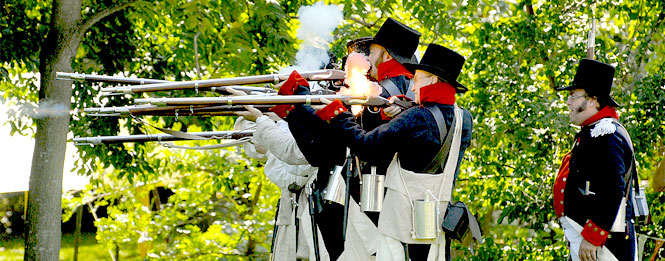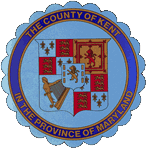The Battle of Caulk's Field

The often forgotten Battle of Caulk’s Field took place in the night of Aug. 30 and early morning hours of Aug. 31, 1814, sandwiched in the week between the burning of Washington and the attack on Fort McHenry.
During that time the British navy had the task of blockading American shipping on the Chesapeake Bay, transporting Royal Marines and sailors to points of attack, and using a fleet of battle-rigged ships of the line to harass and disrupt American military, commerce and regular citizens.
As part of the British Chesapeake Campaign (1813-1815), Capt. Sir Peter Parker, commander of the frigate HM Menelaus, was ordered to distract American militia regiments on Maryland's Eastern Shore that otherwise might be used to aid the defense of the administrative and industrial targets on the other side of the bay.
“Our duty consisted in an eternal annoyance of the enemy, and therefore night and day we were employed in offensive operations,” British Midshipman Frederick Chamier, a member of the Menelaus’ crew, said in an account published years later.
Chamier was only about 18 years old at the time of the Chesapeake warfare, one of the older midshipmen.
Parker, too, was young for the position he held. Born in 1785, the son and grandson of naval officers, he started serving aboard warships as a teen and was promoted to lieutenant in 1801. He once served under the command of Admiral Lord Horatio Nelson before the latter’s death in 1805. And, he had the royal title of baronet.
In 1810 he was given the command of the 38-gun-rated Menelaus which he commanded initially in the war against France. Early in 1814, as the European conflict came to a close, he was ordered to support the war against the United States.
On Aug. 30, Parker’s men attacked the bayshore plantation of Richard Frisby, returning to the ship with booty from the raid that included four slaves. From one of them, the glory-hungry Parker heard that a company of Maryland militiamen was encamped in the vicinity of Bel Air, now called Fairlee. He determined to launch as large a force as possible, comprised of sailors and Royal Marines, to attack them.
There could be no delay; in fact, he was unwilling to await the morning sun. After dinner was taken, Parker ordered the boats readied.
Between 9:30 and 10 p.m. Aug. 30, the boats from Menelaus delivered about 140 marines and sailors in the vicinity of Mendinhall Lake north of Tolchester. Parker and his men were guided by one of the captured slaves. About 10 minutes after they began to move inland, they surprised a picket of four or five militia cavalry. Some of the sailors fired at the cavalry.
Chamier noted in his account: “The Americans, startled into activity by the unwelcome salute, returned the fire with equal precipitation and bad aim; after which they galloped off into a wood in the vicinity. Here they fired a single pistol; it was answered by one at some distance; and that again was answered at the camp by a field-piece.”
The alarm was received by the waiting 21st Regiment of Maryland Militia and its commander, Lt. Col. Philip Reed.
Born about 1760, Reed was a Revolutionary War veteran field officer of the Maryland Continental Line, one-time county sheriff and former U.S. senator and state delegate. His home was at nearby Huntingfield, near Rock Hall, so he knew the turf well. He commanded a force of 174 men divided into seven companies. His men were armed with muskets, most likely 69-caliber 1795 Harpers Ferry pattern flintlocks, along with five six-pounder field artillery pieces and limited ammunition.
Reed noted in a letter to his commander, Gen. Benjamin Chambers, written after the battle, that he initially thought the British were moving to attack a local plantation, as they had done earlier in the day at the Frisby farm.
“I received information that the barges of the enemy, then lying off Waltham’s farm were moving ashore. I concluded their object was to land and burn the houses, &c. at Waltham’s and made the necessary arrangement to prevent them and to be prepared for an opportunity which I had sought for several days to strike the enemy. During our march to the point threatened, it was discovered that the blow was aimed at our camp,” he wrote.
He then moved his camp and prepared his men for the oncoming British attack.
Under a bright full moon which cast dim shadows on the uncertain ground, Parker led his seasoned British marauders along what is now called Bay Shore Road, turning south on Georgetown Road. While he had started out on foot like the rest of his men, early on they captured a militia horseman who inadvertently rode up on the British column. Parker commandeered the horse and so for a while was mounted. He later dismounted, quite possibly to prevent becoming such an obvious target.

About 1 a.m. the militia rifle corps, led by Reed and Capt. Simon Wickes, waited quietly in the trees facing the path of their opponents. They opened fire when Parker and his men came within rifle shot.
Reed wrote: “The head of the enemy’s column soon presented itself and received the fire of our advance party, at seventy paces distance.”
At this point, the British began taking casualties.
The riflemen then executed a strategic withdrawal to the American right, and the British charged.
“The order to charge reverberated through the wood, and was heard above the firing. We suddenly emerged into an open field, divided by a road, and perfectly surrounded by a thick wood. The road led up a gentle ascent, on the summit of which the enemy had planted five field-pieces directed down the road, and through the defile we had passed,” Chamier later wrote.
Parker, withstanding withering cannon fire, led his men onto the battlefield and engaged Reed’s carefully positioned main force. It was at this point the British took many of their casualties, according to archaeologist Julie M. Schablitsky, who led two site surveys in 2012 and 2013.
“The British charge forced the American skirmishers to retreat, traversing behind the artillery line to rejoin their company on the American right flank. Heavy musket and artillery fire broke out as reported by both sides. In fact, many British casualties probably occurred here, as evidenced by the high number and variety of battlefield artifacts,” her report noted.
“They opened their fire which was very destructive,” British Royal Marine Lt. Benjamin Beynon wrote in a diary entry the day after the battle. “The moment I got to the field and formed, my party fired a volley …” About that point in the battle, Beynon was wounded by a musket ball to his thigh.
The British soldiers bravely forced their way toward Reed’s main line positioned on a rise, through a hail of American artillery and musket fire. In fact, Parker’s second in command, Lt. Henry Crease, made it into the midst of Reed’s camp and briefly captured one of the cannons. However, the fiercest fighting was on the American left flank (British right flank), anchored on the main road, as the British attempted a flanking movement there.
Crease later reported to Vice Admiral Alexander Cochrane: “After a march of between four and five miles, in the country, we found the enemy posted on a plain, surrounded by woods, with the camp in their rear; they were drawn up in line, and perfectly ready to receive us; a single moment was not to be lost; by a smart fire, and instant charge, we commenced the attack, forced them from their position, putting them before us, in full retreat to the rear of the artillery, where they again made a stand, shewing [sic] a disposition to outflank us …”
But two things happened at approximately the same time, bringing the battle to a rapid halt.
First, Reed’s men began to run out of ammunition and so started an organized withdrawal.
Wrote Reed: “… I was informed that in some parts of our line the cartridges were entirely expended, nor did any of the boxes contain more than a very few rounds, although each man brought about twenty into the field. The artillery cartridges were entirely expended. Under these circumstances I ordered the line to fall back to a convenient spot where a part of the line was fortified, when the few remaining cartridges were distributed amongst a part of the line, which was again brought into the field, where it remained for a considerable time, the night preventing a pursuit.”
The British, Reed noted, seemed uninclined to continue the battle – that’s because their brash leader, Parker, who had led the British charge, had been fatally wounded, struck in the leg by buckshot. The wound severed his femoral artery.
“The whole animation of the party died when he drooped,” Chamier said in his account. “The Americans fortunately had begun another retreat; and our ceasing fire only led them to believe that we were following the quicker. Sir Peter’s only words were these: ‘I fear they have done for me … you had better retreat, for the boats are a long way off.”
Beynon noted in his diary that Parker bled to death in about 10 minutes.
Leaderless, the British, led by Crease now, hastily retreated the same way they had come, carrying Parker’s body in a fevered trot through the chaos of darkness and unfamiliar terrain, with the fear of American pursuit on their heels, all the way back to the ship.
The battle had lasted about an hour. When the smoke cleared and the sun rose, the grisly tally was taken. Fourteen British soldiers and sailors, including Parker, and 13-year-old midshipman John T. Sandes, had died. As many as 27 were wounded, some seriously. Three Americans sustained minor wounds.
The field and battle route was littered with the detritus of war – bloodied rags, pieces of uniforms and clothing and jettisoned weapons including the Congreve rocket equipment. The British were unable to use the rockets because the soldier in charge of them was one of the first casualties.
Because of the hasty British retreat, the casualties they sustained, and the loss of their popular leader, it was counted as a clear militia victory at a time when Americans, and particularly Marylanders, needed a morale boost.
Reed wrote: “When it is recollected that very few of our officers or men had ever heard the whistling of a ball … that the [British force] was commanded by Sir Peter Parker of the Menelaus, one of the most distinguished officers in the British navy, and composed … of as fine men as could be selected from the British service, I feel fully justified in the assertion that the gallantry of the officers and men engaged on this occasion could not be excelled by any troops.”
The Americans buried the British dead on the field. They also knew that Parker was probably one of the fatalities, because they found a shoe, with his name in it, which had been abandoned.
Of the 14 killed, a dozen remain buried there today in unmarked graves. (Several years after the battle, Sandes’ family returned his remains to England.)
Crease listed the soldiers and sailors that were killed: Sir Peter Parker, Sandes, Quartermaster Robert Friar, Quartermaster Rowland Robinson, James Perren, swabber, Thomas Doris, sail maker, George Hall, seaman, Marine Sgt. John Evans, and Marine privates William Hooper, William Davis, Robert Johnson, William Rogers, William Powell and Robert Jones.
Parker’s body was initially transferred to Bermuda and interred there. His remains were removed to England, and reinterred at St. Margeret’s Church, Westminster, with ceremony, in May 15, 1815. His monument gives an erroneous account of the battle, claiming it as a British victory.
Chamier lamented Parker’s death: “Thus died Sir Peter Parker: he was a brave, generous and excellent man; rigid in discipline, firm of purpose, resolute in action; and notwithstanding his severity, he must have had some excellent qualifications when the seamen he had severely punished regretted his loss, and wept like children over his coffin.”
The field, named for Isaac Caulk, owner at the time of the battle, remains almost unchanged 200 years later. A memorial, dedicated in 1902, is close to the roadside as a reminder of the battle that took place there. Each year since 2012, on the anniversary, a ceremony has honored the fallen. Now two flags, the Union Jack and the Stars and Stripes fly there.
The ceremony planned on Aug. 31 this year will again involve British and Maryland military officials and special guests. Two new monuments will be unveiled at that time.
Article by Kevin Hemstock



